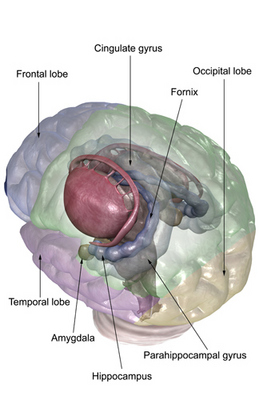
|
| ©3D4Medical.com/Getty Images |
Special cells called intercalated neurons allow animals to overcome fear and anxiety by recalling similar situations when they were unafraid, new research reports. These cells are found in a region of the brain called the amygdala - seen above in a computer image of the human brain.
The finding could lead to new drugs for helping people with anxiety-related conditions such as post-traumatic stress disorder, scientists say.
Previous work had suggested that a part of the brain called the amygdala - an almond-shaped mass of cells deep in the brain - plays an important role in this process, known as fear extinction.
This is what allows soldiers, for example, to learn that some noises they hear on the battlefield might not represent immediate threats when they return home.
Researchers for years have had difficulty determining which of the dozen or so clusters of cells that make up the amygdala is directly responsible.
Now, using a technique that selectively eliminates brain cells, neuroscientist Denis Paré and colleagues have revealed that cells called intercalated (ITC) neurons are crucial for overcoming fear.
"The available data indicates that one does not unlearn fear but instead learns not to fear the threatening stimulus in particular contexts," said Paré, of Rutgers University in New Jersey.
Frozen in Terror
Paré and colleagues demonstrated the importance of ITC neurons by training rats wandering free in cages to associate a certain sound with a mild electric shock to their feet.
This conditioning taught the rats to be afraid of the sound, and they would freeze in place for a few seconds whenever they heard it.
Next the researchers presented the tone without the shock so the rats had memories of hearing the sound without cause for fear.
The following day the team used a targeted drug to render ITC neurons useless in half of the trained rats.
When presented with the tone a week later, rats with intact ITC neurons remembered that the sound no longer signaled an impending shock and continued to act normally.
The animals missing ITC neurons, however, remained afraid of the tone. They froze whenever they heard it, anxiously anticipating a jolt that never came.
The findings support the theory that ITC cells play an important role in forming and expressing so-called extinction memories - remembered moments of safety that help overcome fear.
The research is detailed today in the online edition of the journal Nature.
The discovery could provide drug developers with a new target for treating human phobias and anxiety issues, commented Gregory Quirk, a neuroscientist at the University of Puerto Rico School of Medicine who was not involved in the work.
People afflicted by these disorders may be selecting fear memories in certain situations rather than extinction memories, because their ITC neurons are "turned off," Quirk said.
"If you could just turn up the excitability of these cells with a drug, you could tamp down the fear expression and increase the expression of extinction memories," he said.
Fear Switch
Andreas Lüthi is a neurobiologist at the Friedrich Miescher Institute for Biomedical Research in Switzerland.
He said the new study is "important and elegant," and that it shows for the first time that the amygdala plays an active role in fear inhibition.
According to Lüthi, study leader Paré is "providing the proof that intercalated neurons are necessary to actually maintain [fear] extinction."
In a separate study appearing in this week's Nature, Lüthi and colleagues show that certain neuronal circuits in the amygdala function like switches, allowing animals to also rekindle fear when necessary.
"One could imagine that an animal learns that a particular odor or sound is completely harmless in one context, but in another context, it may signal the presence of a predator," Lüthi said.



Reader Comments
to our Newsletter